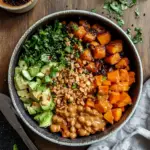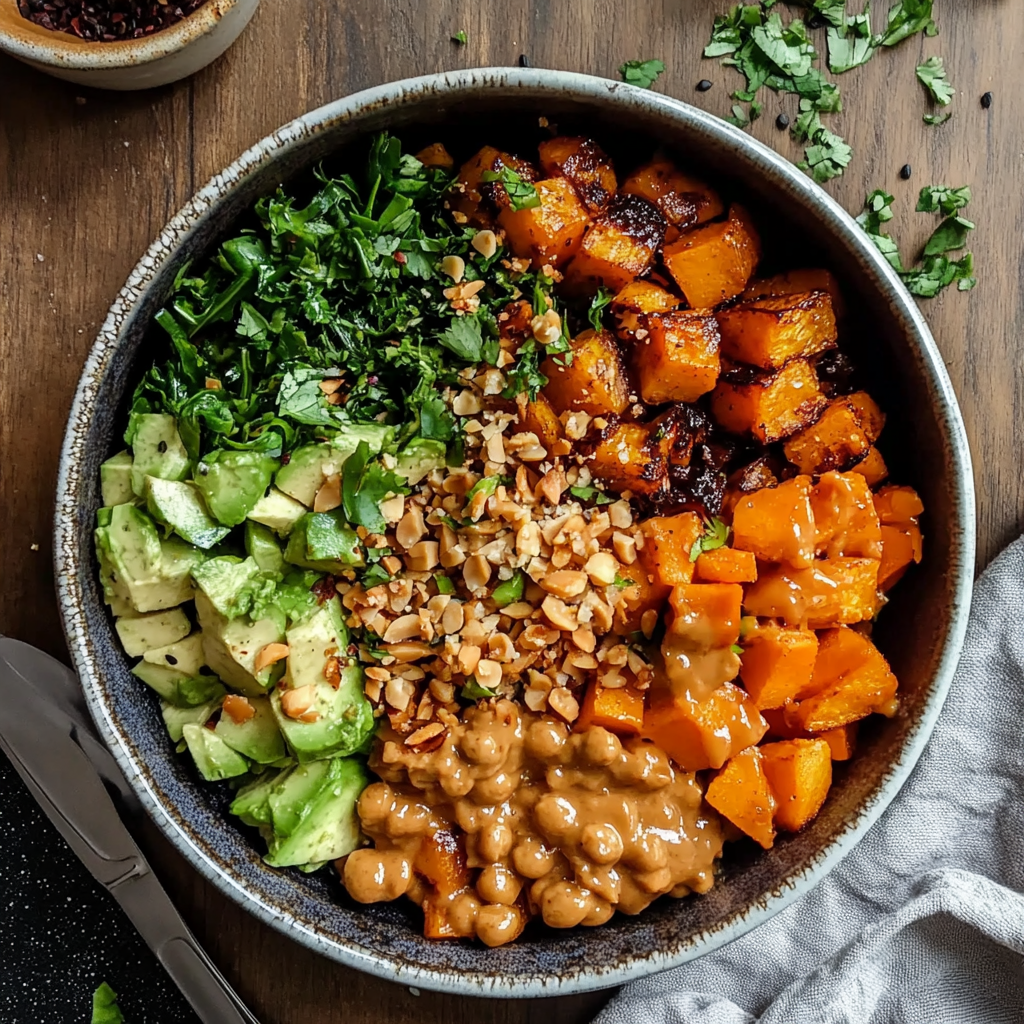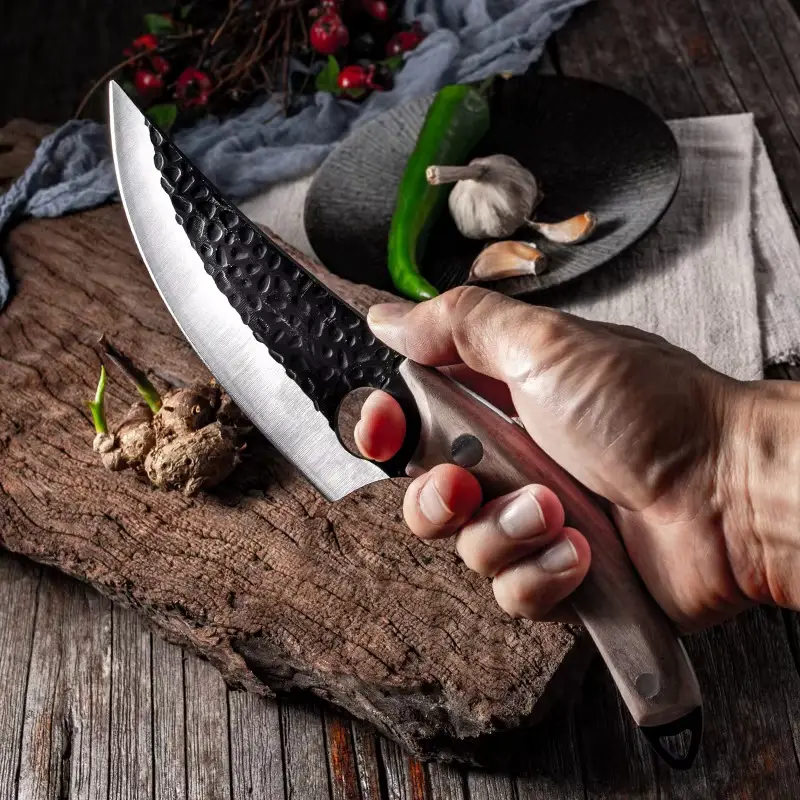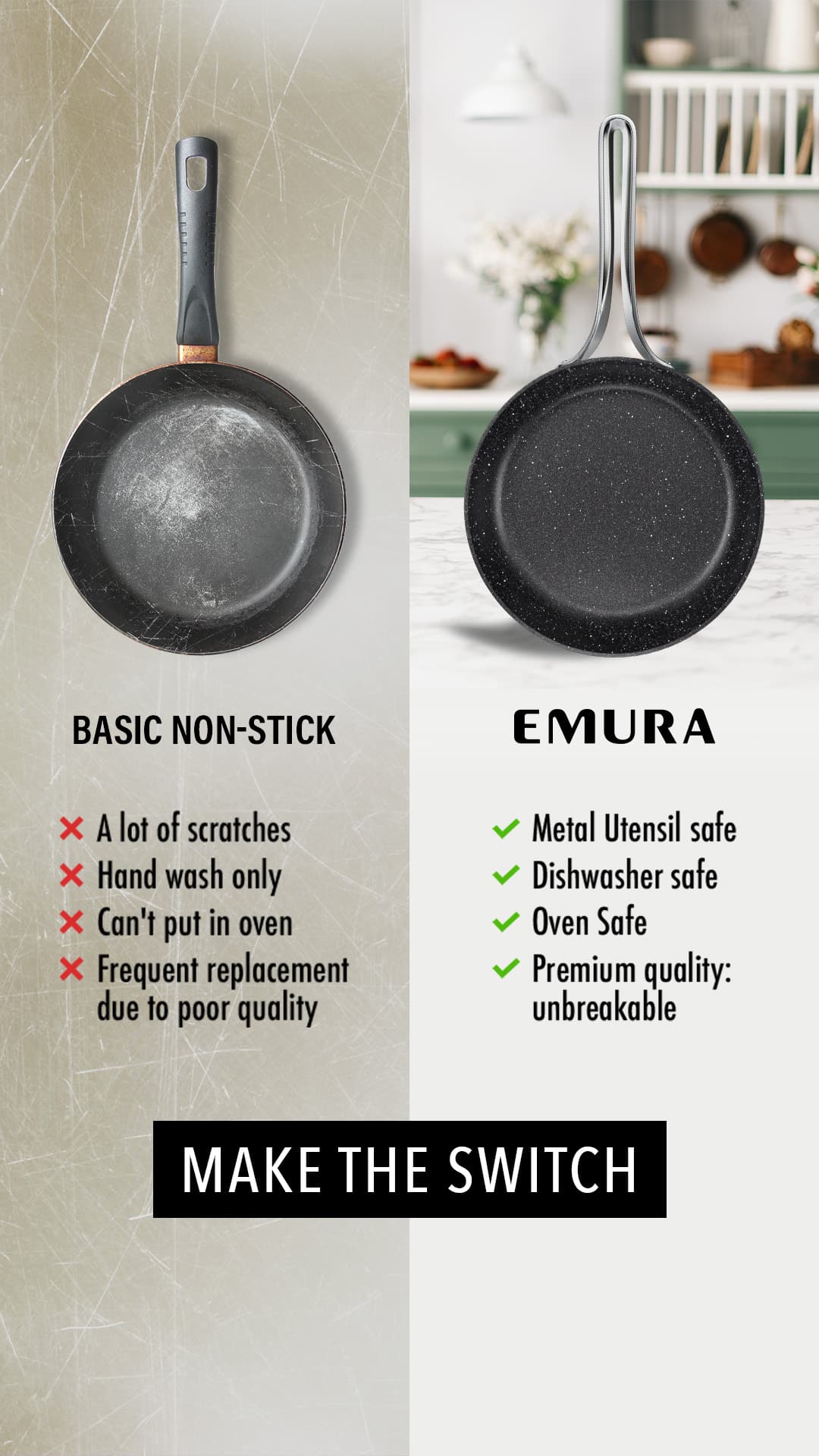A Thai Peanut Sweet Potato Buddha Bowl is a vibrant and wholesome meal packed with bold flavors, nourishing ingredients, and plenty of texture. This dish combines roasted sweet potatoes, fresh vegetables, and protein-rich quinoa, all drizzled with a creamy, tangy Thai peanut sauce that ties everything together.
Perfect for lunch, dinner, or meal prep, this bowl is as visually stunning as it is delicious. The bright orange of the sweet potatoes, the greens of fresh herbs, and the crunch of toppings like peanuts or seeds create a medley of color and taste. Its balance of sweet, savory, and slightly spicy flavors makes it irresistible.
Whether you’re looking for a plant-based option, a dish to impress guests, or a healthy and satisfying weeknight meal, this Thai Peanut Sweet Potato Buddha Bowl is your answer. Let’s dive into this versatile and crowd-pleasing recipe!
Why You’ll Love This Recipe
Nutrient-Packed: Loaded with vitamins, minerals, fiber, and protein for a well-balanced meal.
Customizable: Swap in your favorite veggies, grains, or proteins to make it your own.
Bold Flavors: The peanut sauce is rich, tangy, and slightly sweet, making every bite incredibly flavorful.
Meal Prep Friendly: Prepare the components in advance for easy grab-and-go meals throughout the week.
Plant-Based: Naturally vegan, this bowl is perfect for those seeking meatless options without compromising on taste.
Preparation Time and Servings
- Prep Time: 15 minutes
- Cook Time: 30 minutes
- Total Time: 45 minutes
- Yield: 4 servings
- Serving Size: 1 bowl
Nutritional Information (per serving)
- Calories: 460 kcal
- Carbohydrates: 58g
- Protein: 14g
- Fat: 17g
- Fiber: 9g
- Sugar: 10g
Ingredients
For the Bowl:
- 2 medium sweet potatoes, peeled and diced
- 1 tablespoon olive oil
- 1 teaspoon smoked paprika
- 1/2 teaspoon garlic powder
- Salt and pepper, to taste
- 1 cup quinoa, rinsed and cooked
- 2 cups mixed greens (spinach, kale, or arugula)
- 1 cup shredded purple cabbage
- 1 cup shredded carrots
- 1 red bell pepper, thinly sliced
- 1/4 cup chopped cilantro
- 1/4 cup roasted peanuts or sunflower seeds
For the Thai Peanut Sauce:
- 1/4 cup creamy peanut butter
- 2 tablespoons soy sauce (or tamari for gluten-free)
- 2 tablespoons lime juice (about 1 lime)
- 1 tablespoon sesame oil
- 1 tablespoon maple syrup or honey
- 1 teaspoon grated ginger
- 1–2 teaspoons Sriracha or red chili paste (optional, for heat)
- 2–4 tablespoons warm water (to thin the sauce as needed)
Step-by-Step Instructions
Step 1: Roast the Sweet Potatoes
- Preheat your oven to 400°F (200°C).
- In a large mixing bowl, toss the diced sweet potatoes with olive oil, smoked paprika, garlic powder, salt, and pepper.
- Spread the sweet potatoes in a single layer on a parchment-lined baking sheet. Roast for 25–30 minutes, flipping halfway through, until tender and caramelized at the edges.
Step 2: Cook the Quinoa
- While the sweet potatoes roast, rinse the quinoa thoroughly under cold water.
- In a medium saucepan, combine 1 cup quinoa with 2 cups water or vegetable broth. Bring to a boil, then reduce the heat to low and cover.
- Simmer for 15 minutes or until the liquid is absorbed. Remove from heat and let sit, covered, for 5 minutes. Fluff with a fork.
Step 3: Make the Thai Peanut Sauce
- In a small mixing bowl, whisk together the peanut butter, soy sauce, lime juice, sesame oil, maple syrup, ginger, and Sriracha (if using).
- Gradually add warm water, 1 tablespoon at a time, until the sauce reaches your desired consistency. It should be smooth and pourable.
Step 4: Assemble the Bowls
- Divide the cooked quinoa and mixed greens among four bowls.
- Top each bowl with roasted sweet potatoes, shredded cabbage, carrots, red bell pepper, and any additional toppings like cilantro or peanuts.
- Drizzle generously with the Thai peanut sauce and serve immediately.
Ingredient Background
Sweet Potatoes: Rich in beta-carotene, fiber, and natural sweetness, sweet potatoes are a nutritious and flavorful base for this dish.
Quinoa: A protein-packed grain that adds a fluffy texture and nutty flavor, perfect for soaking up the peanut sauce.
Peanut Butter: The star ingredient in the sauce, peanut butter provides a creamy, nutty richness that ties the bowl together.
Soy Sauce: Adds a savory, umami depth to the sauce. Gluten-free tamari or coconut aminos can be substituted if needed.
Lime Juice: The acidity balances the richness of the peanut butter and enhances the overall flavor.
Technique Tips
Even Roasting: Cut the sweet potatoes into uniform pieces to ensure even roasting and caramelization.
Thin the Sauce Gradually: Add water to the peanut sauce slowly, whisking as you go, to achieve the perfect consistency without over-thinning.
Prep Ahead: Cook the quinoa and make the peanut sauce in advance to streamline assembly.
Customize Toppings: Don’t hesitate to swap or add ingredients like avocado, edamame, or crispy tofu to suit your preferences.
Alternative Presentation Ideas
Jar Salad: Layer the ingredients in a mason jar for a portable, make-ahead lunch option.
Wraps: Use the components as a filling for whole-grain tortillas to create hearty wraps.
Platter Style: Arrange all the ingredients on a large serving platter for a family-style meal where everyone can build their own bowls.
Appetizer Cups: Assemble mini versions in small bowls or cups for an elegant appetizer presentation.
Additional Tips for Success
Balance the Flavors: Adjust the peanut sauce ingredients to your taste—add more lime for tang, maple syrup for sweetness, or Sriracha for heat.
Serve Fresh: Assemble the bowls just before serving to keep the greens crisp and vibrant.
Layer Textures: Include both raw and cooked elements for a satisfying variety of textures in every bite.
Recipe Variations
Spicy Thai Bowl: For those who love a kick, increase the amount of Sriracha or add chili paste to the peanut sauce for a spicier profile. You can also garnish the bowl with sliced jalapeños or crushed red pepper flakes for added heat. For an even bolder flavor, marinate the sweet potatoes in a mixture of chili oil and soy sauce before roasting.
Protein Boost: Elevate the bowl by incorporating your favorite protein. Grilled chicken and shrimp complement the peanut sauce beautifully, while crispy tofu offers a plant-based alternative with great texture. Tempeh or even a poached egg can be added for extra protein and richness.
Low-Carb Option: Swap the quinoa with cauliflower rice to create a low-carb version that’s just as satisfying. Zucchini noodles or spaghetti squash are also excellent substitutions that work well with the peanut sauce and toppings.
Nut-Free Version: For a nut-free option, replace peanut butter with sunflower seed butter or tahini. Ensure the toppings, like peanuts, are also omitted or replaced with roasted pumpkin seeds or sesame seeds for added crunch and nut-free texture.
Freezing and Storing
Refrigeration: To preserve freshness, store the components separately in airtight containers in the refrigerator for up to 4 days. This ensures the greens remain crisp and the roasted sweet potatoes retain their caramelized texture. Assemble the bowls just before serving to maintain the best quality.
Freezing: Roasted sweet potatoes and cooked quinoa freeze exceptionally well. Place them in individual freezer-safe bags or containers, removing as much air as possible to prevent freezer burn. Freeze for up to 2 months. Thaw overnight in the refrigerator and reheat on the stovetop or in the microwave. For the peanut sauce, make it fresh whenever possible, but if you need to freeze it, use a small container and freeze for up to 1 month. Stir well after thawing to restore its smooth consistency.
Reheating Tip: When reheating the sweet potatoes or quinoa, add a splash of water or vegetable broth to prevent dryness. Warm them in the microwave or on the stovetop over low heat for the best results.
Serving Suggestions for Events
Lunch Gathering: Arrange all the components in separate bowls or platters for a build-your-own-bowl bar. Guests can customize their bowls by selecting their preferred toppings, proteins, and sauce levels. Provide extra garnishes like lime wedges, peanuts, or sesame seeds for added flair.
Dinner Party: Present the bowls fully assembled on decorative plates or shallow bowls. Drizzle each with extra peanut sauce and garnish with fresh cilantro, lime slices, and a sprinkle of toasted sesame seeds. Pair with a crisp white wine or a refreshing iced green tea for a complete meal.
Meal Prep: Divide the sweet potatoes, quinoa, and vegetables into individual meal prep containers. Store the peanut sauce in small, separate containers to drizzle just before eating. These bowls make excellent grab-and-go lunches or quick weeknight dinners that are healthy, satisfying, and full of flavor.
Picnic Delight: Pack the roasted sweet potatoes, quinoa, and toppings in individual containers or bento boxes for easy transport. Assemble the bowls on-site for ultimate freshness. Bring a small jar of the peanut sauce to drizzle just before serving, and enjoy a vibrant, healthy picnic meal outdoors.
Special Equipment
Baking Sheet: A sturdy, rimmed baking sheet is essential for roasting the sweet potatoes evenly. The rim prevents any olive oil or spices from spilling over during cooking, ensuring easy cleanup and perfectly caramelized edges.
Saucepan: A medium-sized saucepan is ideal for cooking fluffy quinoa. Using vegetable broth instead of water in the saucepan adds extra flavor to the quinoa, making it an even better base for the bowl.
Whisk: A whisk is key for blending the peanut sauce ingredients smoothly. It ensures that the peanut butter, soy sauce, and lime juice emulsify properly, creating a creamy and pourable sauce.
Sharp Knife: Precision is crucial when slicing vegetables for an even and attractive presentation. A sharp knife makes quick work of dicing sweet potatoes, julienning bell peppers, or shredding cabbage, ensuring a professional and visually appealing result.
Optional Equipment: A mandoline slicer can be used for creating thin, even vegetable slices, while a food processor simplifies shredding carrots or cabbage. Both tools save time and effort during prep.
Frequently Asked Questions (FAQs)
1. Can I make this bowl ahead of time?
Yes! Prepare all the components in advance and store them separately. Assemble the bowl fresh to keep the greens crisp.
2. Can I substitute the quinoa?
Absolutely. Brown rice, couscous, or farro are excellent alternatives.
3. Is the peanut sauce spicy?
The sauce has mild heat if you add Sriracha or chili paste. Adjust the amount to your preference or omit it for a non-spicy version.
4. How do I store leftovers?
Store each component in a separate airtight container in the refrigerator for up to 4 days.
5. Can I make this nut-free?
Yes, substitute peanut butter with sunflower seed butter and omit any peanut toppings.
6. What are the best sweet potatoes for this recipe?
Orange-fleshed sweet potatoes like Beauregard or Jewel work best due to their natural sweetness and creamy texture when roasted.
7. Can I add meat to this bowl?
Definitely. Grilled chicken, shrimp, or even steak are great protein options.
8. How do I thin out the peanut sauce if it’s too thick?
Add warm water, 1 tablespoon at a time, whisking until the desired consistency is reached.
Conclusion
The Thai Peanut Sweet Potato Buddha Bowl is a perfect blend of flavors, textures, and nutrients. From the caramelized roasted sweet potatoes to the creamy peanut sauce, every element works together to create a dish that’s as nourishing as it is delicious. Whether you’re looking for a plant-based meal, a customizable bowl for guests, or a make-ahead lunch option, this recipe has you covered.
With its vibrant colors and bold flavors, this dish is sure to impress, whether it’s a casual dinner at home or part of a larger gathering. Easy to prepare, adaptable, and utterly satisfying, this Thai Peanut Sweet Potato Buddha Bowl is a recipe you’ll find yourself returning to again and again. Give it a try—you’ll be hooked on its irresistible combination of taste and healthfulness!
Print
Thai Peanut Sweet Potato Buddha Bowl
- Total Time: 45 minutes
- Yield: 4 servings 1x
Ingredients
For the Bowl:
- 2 medium sweet potatoes, peeled and diced
- 1 tablespoon olive oil
- 1 teaspoon smoked paprika
- 1/2 teaspoon garlic powder
- Salt and pepper, to taste
- 1 cup quinoa, rinsed and cooked
- 2 cups mixed greens (spinach, kale, or arugula)
- 1 cup shredded purple cabbage
- 1 cup shredded carrots
- 1 red bell pepper, thinly sliced
- 1/4 cup chopped cilantro
- 1/4 cup roasted peanuts or sunflower seeds
For the Thai Peanut Sauce:
- 1/4 cup creamy peanut butter
- 2 tablespoons soy sauce (or tamari for gluten-free)
- 2 tablespoons lime juice (about 1 lime)
- 1 tablespoon sesame oil
- 1 tablespoon maple syrup or honey
- 1 teaspoon grated ginger
- 1–2 teaspoons Sriracha or red chili paste (optional, for heat)
- 2–4 tablespoons warm water (to thin the sauce as needed)
Instructions
Step 1: Roast the Sweet Potatoes
- Preheat your oven to 400°F (200°C).
- In a large mixing bowl, toss the diced sweet potatoes with olive oil, smoked paprika, garlic powder, salt, and pepper.
- Spread the sweet potatoes in a single layer on a parchment-lined baking sheet. Roast for 25–30 minutes, flipping halfway through, until tender and caramelized at the edges.
Step 2: Cook the Quinoa
- While the sweet potatoes roast, rinse the quinoa thoroughly under cold water.
- In a medium saucepan, combine 1 cup quinoa with 2 cups water or vegetable broth. Bring to a boil, then reduce the heat to low and cover.
- Simmer for 15 minutes or until the liquid is absorbed. Remove from heat and let sit, covered, for 5 minutes. Fluff with a fork.
Step 3: Make the Thai Peanut Sauce
- In a small mixing bowl, whisk together the peanut butter, soy sauce, lime juice, sesame oil, maple syrup, ginger, and Sriracha (if using).
- Gradually add warm water, 1 tablespoon at a time, until the sauce reaches your desired consistency. It should be smooth and pourable.
Step 4: Assemble the Bowls
- Divide the cooked quinoa and mixed greens among four bowls.
- Top each bowl with roasted sweet potatoes, shredded cabbage, carrots, red bell pepper, and any additional toppings like cilantro or peanuts.
- Drizzle generously with the Thai peanut sauce and serve immediately.
- Prep Time: 15 minutes
- Cook Time: 30 minutes
Nutrition
- Serving Size: 1 bowl
- Calories: 460 kcal
- Sugar: 10g
- Fat: 17g
- Carbohydrates: 58g
- Fiber: 9g
- Protein: 14g



